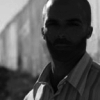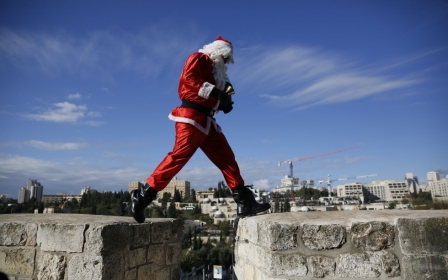Understanding settler-colonialism through the microcosm of Bethlehem

The huge Christmas tree lit up outside Bethlehem's Church of the Nativity stands within a couple of square kilometres that is expected to host up to 100,000 tourists over Christmas. Across Manger Square stands a much smaller tree, not a Christmas tree as is traditionally seen. From its branches hang spent tear gas canisters labelled in Hebrew. This tree was not decorated from within Bethlehem Municipality's Christmas tourism budget, instead it was created by local activists in an attempt to open the eyes of tourists to even a glimpse of life in the area today.
What will be a “once-in-a-lifetime” trip for many visiting tourists and pilgrims, will in most cases be restricted to seeing just a face of the area that reveals little about the daily lives of the 180,000 Palestinians who live in the Bethlehem district. The tourists who fill the city centre will be based within only a fraction of the PA-controlled Bethlehem land, which itself is only a fraction of the Bethlehem district. In the “City of Peace” and its surrounding area, life continues to be shaped by Zionist settler-colonialism in a process that has been ongoing for several decades.
In the late 1940's and early 1950's, Bethlehem was hit by a mass influx of Palestinian refugees following al-Nakba. Three refugee camps were established inside the city, but even these ghettos of exile did not accommodate all the refugees that came to the area. This “temporary” base for people who had been forced from their homes by Zionist militias inside what had become the “State of Israel” today, also accommodates several generations that have followed these original refugees. All remain in enforced exile, denied their “Right of Return” as has been stipulated in UN Resolution 194. Today, figures generated by BADIL Resource Centre based on forecasts of the Palestinian Central Bureau of Statistics, estimate that around 60,000 refugees live in the Bethlehem district.
In 1967, following the beginning of the Israeli occupation of the West Bank including East Jerusalem, the Gaza Strip and the Golan Heights, the Israeli colonisation of Bethlehem began. As Israel began to put in to place its “Greater Jerusalem” plans, it annexed 10 square kilometres of Bethlehem land as it expanded the boundaries of Jerusalem. Simultaneously, Israel began its “settlement” or “colony” building inside the West Bank.
Amongst Israel's first West Bank colonial constructions was the foundations of the Etzion bloc, which today runs in a continuous seam through the West Bank from Bethlehem south to Hebron. From these roots, the settler-colonial project in the Bethlehem district has constructed 35 colonies on land which lies within the Bethlehem district. In 2009, UNOCHA estimated that these colonies house 86,000 Israeli settlers, and with continued construction, that number today will be noticeably higher.
The power and ongoing nature of this colonial project was highlighted again in recent months with a mass confiscation of land in the Bethlehem area to extend work that began decades ago. In the mid 1980's Gva'ot colony was first established as an Israeli military base on land between the Bethlehem area villages of al-Jaba'a and Nahhalin. In August this year, Israel announced the confiscation of 4,000 dunums (approximately 1,000 acres) of land for the latest extension of Gva'ot and the wider Gush Etzion bloc. Israel's Peace Now believes this is the largest single confiscation of land since the 1980's.
Israeli colonies have usurped land across Palestine and continue to do so, yet understanding settler-colonialism involves a deeper look at the various tools used to confiscate Palestinian land. In the Oslo Accords (itself a colonial project), 66 percent of the entire land of the Bethlehem district was declared “Area C” and therefore, remains under full Israeli military and civil control. Of this “Area C” land, huge swathes have been classified by Israel as “nature reserves” and “closed military zones”. Israeli “closed military zones” are the single largest confiscation of Bethlehem's land and amount to 31,000 hectares (more than 76,000 acres) according to the Applied Research Institute of Jerusalem (ARIJ).
Israel's “Apartheid Wall” added another string to the bow of land colonisation in the Bethlehem area. The Wall today runs deep inside the city of Bethlehem to surround the Rachel's Tomb complex and imprisons the city. But its devastation of the wider district is even starker. Once its construction is complete, an estimated 74 square kilometres of Bethlehem district will be isolated on the western side of the Wall.
Whilst Bethlehem is still touted as the “City of Peace” today it is a city, or rather a district, of many fragmented and colonised pieces. The tourists who spend the coming days in and around Manger Square and the Church of the Nativity will gain little understanding of this wider context within those brightly lit up and celebrated areas. The Bethlehem district is far from unique in its struggle against Israeli settler-colonialism. Rather, it is simply a microcosm of what has happened and continues to happen to all areas of Palestine.
The entire Bethlehem district measures approximately 660 square kilometres. UNOCHA estimates that today only 13 percent of that land "is available for Palestinian use". Such stark acknowledgements are the most valuable thing that Bethlehem's international tourists could today take away from the city when they travel back to their home countries.
Looking at Bethlehem, or any of Palestine through the restrictive political prism of occupation does not do justice to Palestine's realities. The microcosm of Palestine that is today's Bethlehem district, for those who truly want to understand what it means, is a clear portrayal of a 21st century settler-colonial project that is not only allowed to continue long after the supposed end of the “post-colonial period”, but is, in fact, being supported politically and even paid for by international governments and their taxpayers. Breaking this system involves a real understanding of its dynamics followed by a global concerted effort to break this chain of oppression and abuse. Palestinians will continue their internal struggle against settler-colonialism but they need much more international support in-line with their inalienable rights.
If 2015 is to bring anything new for Palestine, it must be built from the ground up - led by Palestinians themselves - but supported with continued growth and activism globally within the Palestinian campaign for boycott, divestment and sanctions. The world's people must not allow themselves to be party to these crimes.
Colonial projects in many of the world countries were broken in the last century by determined and principled activism which refused to negotiate on the rights themselves. Negotiations for Palestine's future - of which have no doubt there will be more - must follow a similar path. Zionist settler-colonialism must first be understood for what it is, and it must then be broken. Then, maybe one day, the “City of Peace” moniker may not sound quite as empty as it does today.
New MEE newsletter: Jerusalem Dispatch
Sign up to get the latest insights and analysis on Israel-Palestine, alongside Turkey Unpacked and other MEE newsletters
Middle East Eye delivers independent and unrivalled coverage and analysis of the Middle East, North Africa and beyond. To learn more about republishing this content and the associated fees, please fill out this form. More about MEE can be found here.




